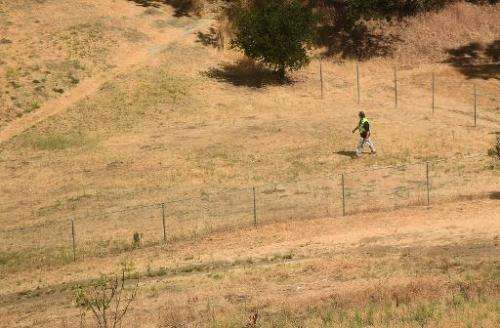This picture taken from a helicopter shows a drought affected area on the outskirts of San Francisco, California, on July 23, 2014
A major drought across the western United States has sapped underground water resources, posing a greater threat to the water supply than previously understood, scientists said Thursday.
The study involves seven western states—including Arizona, Colorado, Utah, Wyoming, California, New Mexico and Nevada—in an area known as the Colorado River Basin.
Since 2000, the region has seen the driest 14-year period in a century, and researchers now say three quarters of the water loss has come from underground.
The total amount of water loss is almost double the volume of the nation's largest reservoir, Nevada's Lake Mead, said the study in the journal Geophysical Research Letters.
From 2004 to 2013, satellite data has shown that the basin lost nearly 53 million acre feet (65 cubic kilometers) of freshwater, it said.
"This is a lot of water to lose. We thought that the picture could be pretty bad, but this was shocking," said lead study author Stephanie Castle, a water resources specialist at the University of California, Irvine.
"We don't know exactly how much groundwater we have left, so we don't know when we're going to run out," added Castle.
NASA said the study is "the first to quantify the amount that groundwater contributes to the water needs of western states."
This picture taken from a helicopter shows a drought affected area near Los Altos Hills, California, on July 23, 2014
The data came from the NASA's Gravity Recovery and Climate Experiment (GRACE) satellite, a joint mission with the German Aerospace Center and the German Research Center for Geosciences.
Experts say water levels and losses in rivers and lakes is well documented, but underground aquifers are not as well understood.
The satellite was able to detect below ground water by measuring the gravitational pull of the region as it changed over time due to rising or falling water reserves.
The Colorado River Basin supplies water to some 40 million people in seven states, and irrigates about four million acres (1.6 million hectares) of farmland.
"The Colorado River Basin is the water lifeline of the western United States," said senior author Jay Famiglietti, senior water cycle scientist at NASA's Jet Propulsion Laboratory.
He said the basin, like others worldwide, was relying on groundwater to make up for the limited surface-water supply.
"We found a surprisingly high and long-term reliance on groundwater to bridge the gap between supply and demand," he said.
"Combined with declining snowpack and population growth, this will likely threaten the long-term ability of the basin to meet its water allocation commitments to the seven basin states and to Mexico," Famiglietti said.
Journal information: Geophysical Research Letters
© 2014 AFP
























